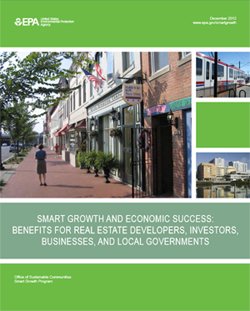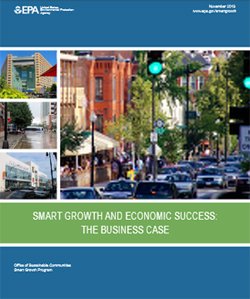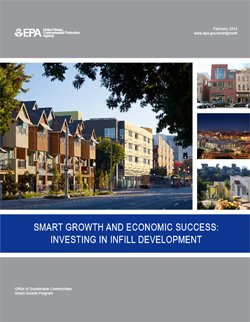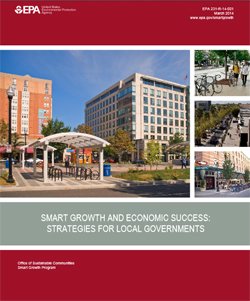Smart Growth and Economic Success
EPA developed a series of reports outlining the business case and financial benefits for undertaking smart growth approaches. The series provides evidence, case studies and strategies for developers, investors, businesses and local governments to consider and implement to reap economic successes and promote strong fiscal policy.
On this page:
- Smart Growth and Economic Success: Benefits for Real Estate Developers, Investors, Business, and Local Governments
- Smart Growth and Economic Success: The Business Case
- Smart Growth and Economic Success: Investing in Infill Development
- Smart Growth and Economic Success: Strategies for Local Governments
Smart Growth and Economic Success: Benefits for Real Estate Developers, Investors, Business, and Local Governments

Smart Growth and Economic Success: Benefits for Real Estate Developers, Investors, Business, and Local Governments (pdf) (2012) is the first in a series of reports designed to inform developers, businesses, local governments and other groups about the benefits of smart growth development.
This report incorporated feedback from a 2011 workshop in which business leaders, real estate developers, and economic development professionals discussed how to expand on work in this area.
Some of the advantages for developers, communities, and local governments associated with smart growth include:
- Compact development: Compact development can generate more revenue per acre because it uses land more efficiently. It can reduce the costs of land and infrastructure for individual projects and the costs of providing public services and amenities. Locating companies close together can create a density of employment that increases economic productivity and attracts additional investment.
- Walkability: Projects in walkable neighborhoods command a price premium, earning real estate developers and investors a higher return on investment. Neighborhoods that are more appealing to pedestrians can attract customers to local businesses, which benefits local governments by generating more property and sales tax revenue.
- Range of choices: The demand for homes in smart growth neighborhoods exceeds the supply. Changing demographics will likely further increase the demand for smart growth development. Developers, investors, businesses, and local governments that respond to these market preferences could reap economic advantages.
Smart Growth and Economic Success: The Business Case

Many businesses have recognized that compact, walkable downtowns are good for business and are choosing their operating locations accordingly.
Smart Growth and Economic Success: The Business Case (pdf) (2013) discusses how locations with housing and transportation options, a mix of uses close together, and a high quality of life can improve environmental outcomes while providing economic advantages for businesses.
Some benefits include:
- Increased productivity and innovation: Easier access to labor, suppliers, and supporting businesses improves productivity. An environment that enables and encourages social interaction both within and among firms leads to more idea exchange, innovation, and collaboration. Making it easy for employees to incorporate physical activity into their daily commutes improves their health and well-being, reducing absenteeism and health care costs.
- Improved ability to compete for labor: Many workers, including young professionals, prefer to live near where they work and to be able to walk to shops, restaurants, and entertainment. Low-wage workers need access to affordable housing near jobs and transportation options. Businesses in walkable central business districts near transit can meet the needs of both these groups, making it easier to recruit employees.
- Stronger retail sales: Stores find it easier to attract customers when they are in locations that can be reached in multiple ways and provide a diverse, vibrant environment.
Smart Growth and Economic Success: Investing in Infill Development

Developers of all sizes are building infill projects throughout the country, and are doing so profitably. Nevertheless, infill development can present a distinct set of challenges.
Smart Growth and Economic Success: Investing in Infill Development (pdf) (2014) discusses how these barriers can be overcome.
Trends point to a sustained increase in demand for infill development, creating a market opportunity for developers:
- Changing demographics and preferences: In the next 20 years, the needs and preferences of aging baby boomers, new households, and one-person households will drive real estate market trends, and infill locations are likely to attract many of these people.
- Employer behavior: As more people choose to live in infill neighborhoods, employers are following, and vice versa. Many corporations are moving to infill locations, in part because they recognize the competitive advantages of being closer to the central city.
These trends give developers economic incentives to find solutions to potential barriers to infill. Even if land is more expensive in these locations, infill projects tend to attract higher rents and sales prices that can help make them profitable.
Local governments are helping as well. By changing the regulatory environment to encourage infill, local governments encourage development that uses existing infrastructure, cleans up and repurposes contaminated and neglected sites, helps reduce transportation-related pollution, and reduces development pressure on outlying areas.
Smart Growth and Economic Success: Strategies for Local Governments

Smart growth strategies can help local governments build on existing assets and maximize the return on investment while helping to protect the environment and human health.
Smart Growth and Economic Success: Strategies for Local Governments (pdf) (2014) presents evidence of the connection between smart growth approaches and the fiscal strength of local governments to help them make decisions about where and how to grow.
Strategies for local governments to lower costs and/or increase revenue include:
- Compact development in established town and city centers: Water, sewer, and road infrastructure cost less in compact development than in more dispersed development. In addition, ongoing expenses, including those for police, fire, and emergency services; street maintenance; and trash removal, are higher per capita when development is dispersed and infrastructure must serve people across a larger geographic area.
- Transit connecting homes and jobs: Smart growth development can help communities maximize property tax revenue without raising tax rates because properties near transit and compact, walkable, mixed-use development in established town and city centers are associated with higher property values.
- Neighborhoods and streets that make walking and biking safe, convenient, and enjoyable: Investing in making retail districts more walkable and bikeable helps businesses and restaurants fill empty storefronts and increase sales, raising sales tax revenue for local governments.
